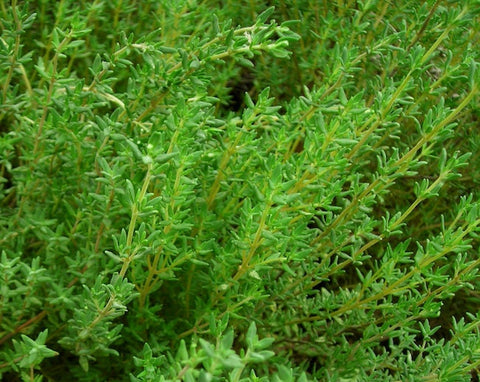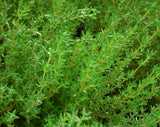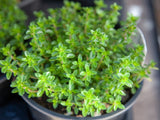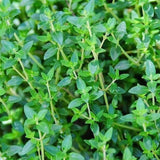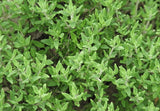Thyme Herb Seeds - Organic - Non-GMO - Heirloom VarietyThyme is a cold hardy perennial that grows as a trailing shrub. Native to the Mediterranean, organic thyme develops sage-green leaves producing earthy, floral flavor similar to rosemary—as it is an evergreen member of the mint family! Organic Common Thyme thrives during the summer as an aromatic herb popular for its gardening benefits and timeless versatility.cOUNT: ~250
Latin Name: Thymus vulgaris, Genus Thymus Species Origin: Mediterranean, Southern Europe Type: Open Pollinated, Heirloom, Warm Season Life Cycle: Perennial USDA Zones: 5, 6, 7, 8, 9, 10, 11, 12 Seeds per Ounce: 100,000 Planting Method: From Transplant Sunlight: Full Sun Height: 8 Inches Color: Green Bloom Season: Blooms Early Summer, Blooms Late Summer Uses: Attracts Honeybees, Attracts Butterflies, Aromatic, Deer Resistant Color: Aromatic sage-green leaves, pink-to-purple flowers Flavor: Slight floral and mint, earthy, similar to rosemary Days to Maturity: 80-90+ Perennial Pests/Diseases: Aphids, root rot, downy mildew Growth Habit: Upright/low-growth/trailing shrub/evergreen Soil Preference: Moderately rich, dry and well-drained Temp Preference: WarmGreat fresh or dried, Thyme is an indispensable kitchen herb. The whole plant of Common Thyme is used to flavor a wide variety of dishes. It can also be used as an aromatic, ornamental landscape herb. It is drought tolerant and attractive to bees, butterflies, and birds. Native to southern Europe and the Mediterranean, thyme has a well established reputation for providing healing and protection; it also symbolizes courage, bravery, and strength. For centuries, soldiers would wear or carry sprigs of thyme with them to battle with the belief that the herb would protect them from danger. For culinary use, it is most often paired with lamb, poultry, or lemon; thyme makes one of the finest flavors of honey, and the plant attracts many bees. Medieval herbalists treated poisonous stings or bites with this herb, or burned it to purify the air. During the time of the Black Death, thyme became a major ingredient in many treatments for the disease. Whether or not it actually performed a cure, recent research confirms that thyme contains a very powerful antiseptic that may have medical benefits; records show several instances of thyme syrup completely curing whooping cough within a week. Though culinary use is fine, pregnant women should not take medicinal doses of thyme.Sowing: Start thyme indoors 5-6 weeks before the last frost, sowing them 1/4" deep in a flat. Keep them out of direct sunlight, but make sure the soil temperature is at least 70 degrees F. Germination may take up to 28 days. Well after the last frost, transplant the seedlings in sandy soil and full sun. Direct sowing is possible but not recommended, since the seeds take much longer to germinate in the cool soil of spring; this significantly shortens the growing season and delays the harvest of fresh leaves.Growing: Make sure the seedlings have adequate moisture, but as soon as they are established do not water them. Thyme thrives on neglect, preferring dry soil with no fertilization. If the soil becomes too wet, the plant may suffer from root rot or other fungal diseases. Control weeds to prevent them from competing with the slow developing thyme. Mulch may help to keep the leaves clean and discourage weeds. After the second spring of the plants' growth, prune the plants down to half their height to encourage tender stems and neat growth. Thyme grows well as a container plant, and can be propogated from cuttings or root division. As a companion plant, thyme attracts bees and discourages harmful insects such as the cabbage butterfly.Harvesting: Harvest fresh leaves as soon as they reach a desirable size, cutting them down to 1-2" above ground level. The best time to harvest is in the morning after the dew has dried. The leaves reach their peak in flavor right before the flowers open; after this point the flavor decreases. To dry entire sprigs, bundle them and hang them upside down in a warm place out of direct sunlight. After they have dried, rub them lightly to separate the leaves from the stems. Store the leaves in an airtight container.Seed Saving: Harvest individual seed heads as they mature and begin to dry. Spread them out to dry out of direct sunlight, then thresh them to remove the seed. Store the seed in a cool, dry place.
Latin Name: Thymus vulgaris, Genus Thymus Species Origin: Mediterranean, Southern Europe Type: Open Pollinated, Heirloom, Warm Season Life Cycle: Perennial USDA Zones: 5, 6, 7, 8, 9, 10, 11, 12 Seeds per Ounce: 100,000 Planting Method: From Transplant Sunlight: Full Sun Height: 8 Inches Color: Green Bloom Season: Blooms Early Summer, Blooms Late Summer Uses: Attracts Honeybees, Attracts Butterflies, Aromatic, Deer Resistant Color: Aromatic sage-green leaves, pink-to-purple flowers Flavor: Slight floral and mint, earthy, similar to rosemary Days to Maturity: 80-90+ Perennial Pests/Diseases: Aphids, root rot, downy mildew Growth Habit: Upright/low-growth/trailing shrub/evergreen Soil Preference: Moderately rich, dry and well-drained Temp Preference: WarmGreat fresh or dried, Thyme is an indispensable kitchen herb. The whole plant of Common Thyme is used to flavor a wide variety of dishes. It can also be used as an aromatic, ornamental landscape herb. It is drought tolerant and attractive to bees, butterflies, and birds. Native to southern Europe and the Mediterranean, thyme has a well established reputation for providing healing and protection; it also symbolizes courage, bravery, and strength. For centuries, soldiers would wear or carry sprigs of thyme with them to battle with the belief that the herb would protect them from danger. For culinary use, it is most often paired with lamb, poultry, or lemon; thyme makes one of the finest flavors of honey, and the plant attracts many bees. Medieval herbalists treated poisonous stings or bites with this herb, or burned it to purify the air. During the time of the Black Death, thyme became a major ingredient in many treatments for the disease. Whether or not it actually performed a cure, recent research confirms that thyme contains a very powerful antiseptic that may have medical benefits; records show several instances of thyme syrup completely curing whooping cough within a week. Though culinary use is fine, pregnant women should not take medicinal doses of thyme.Sowing: Start thyme indoors 5-6 weeks before the last frost, sowing them 1/4" deep in a flat. Keep them out of direct sunlight, but make sure the soil temperature is at least 70 degrees F. Germination may take up to 28 days. Well after the last frost, transplant the seedlings in sandy soil and full sun. Direct sowing is possible but not recommended, since the seeds take much longer to germinate in the cool soil of spring; this significantly shortens the growing season and delays the harvest of fresh leaves.Growing: Make sure the seedlings have adequate moisture, but as soon as they are established do not water them. Thyme thrives on neglect, preferring dry soil with no fertilization. If the soil becomes too wet, the plant may suffer from root rot or other fungal diseases. Control weeds to prevent them from competing with the slow developing thyme. Mulch may help to keep the leaves clean and discourage weeds. After the second spring of the plants' growth, prune the plants down to half their height to encourage tender stems and neat growth. Thyme grows well as a container plant, and can be propogated from cuttings or root division. As a companion plant, thyme attracts bees and discourages harmful insects such as the cabbage butterfly.Harvesting: Harvest fresh leaves as soon as they reach a desirable size, cutting them down to 1-2" above ground level. The best time to harvest is in the morning after the dew has dried. The leaves reach their peak in flavor right before the flowers open; after this point the flavor decreases. To dry entire sprigs, bundle them and hang them upside down in a warm place out of direct sunlight. After they have dried, rub them lightly to separate the leaves from the stems. Store the leaves in an airtight container.Seed Saving: Harvest individual seed heads as they mature and begin to dry. Spread them out to dry out of direct sunlight, then thresh them to remove the seed. Store the seed in a cool, dry place.

